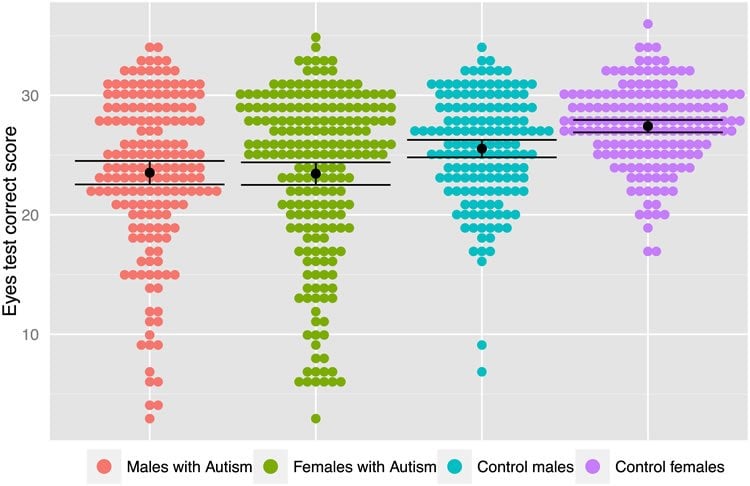New results published by researchers at the Autism Research Centre (ARC) show both men and women with autism show an extreme of the typical male pattern on the ‘Reading the Mind in the Eyes’ test.
Scientists at the University of Cambridge University have published new results in the journal PLoS ONE from the largest ever study of people with autism taking the ‘Reading the Mind in the Eyes’ test. Whilst typical adults showed the predicted and now well-established sex difference on this test, with women on average scoring higher than men, in adults with autism this typical sex difference was conspicuously absent. Instead, both men and women with autism showed an extreme of the typical male pattern on the test, providing strong support for the ‘extreme male brain’ theory of autism.
The study was led by Professor Simon Baron-Cohen, Director of the Autism Research Centre (ARC) at the University of Cambridge. Almost 400 men and women with autism or Asperger Syndrome took the test online, which entails looking at a series of photographs of just the eye region of the face, and picking which of four words best describe what the person in the photo is thinking or feeling.
The ‘Reading the Mind in the Eyes’ test is known as an advanced ‘theory of mind’ or empathy test, designed to reveal subtle individual differences in social sensitivity. It particularly measures the ‘cognitive’ component of empathy, that is, the ability to recognize or infer someone else’s state of mind. The test has been used in hundreds of studies worldwide, showing reliable sex differences in typical individuals, with women on average scoring higher than men, and showing that people with autism score lower on average than people without autism.
The team investigated whether men and women with autism perform differently on this test, and used it to evaluate the ‘extreme male brain’ theory of autism, in the largest study to date. This theory predicts that on tests of empathy, typical females will score higher than typical males, who in turn will score higher than people with autism. The results confirmed this pattern.
Professor Baron-Cohen commented: “We are seeing this pattern not just on the Eyes test but on a number of measures. Last year we saw it on the Empathy Quotient, a self-report measure of social sensitivity, and on the Systemizing Quotient, a self-report measure of one’s interest and aptitude in understanding systems. This year we saw it in prenatal testosterone levels, where boys with autism had elevated levels of this hormone compared to typically developing boys, who in turn have higher levels than typically developing girls. And a decade ago we found how much prenatal testosterone you have influences your scores on the Eyes test. Future research needs to delve into what is giving rise to this pattern.”

Dr Carrie Allison, Research Manager at the ARC and another member of the team, said: “Imagine looking at people’s eyes and not being able to ‘read’ them effortlessly and intuitively for what the other person may be thinking or feeling. This research has the potential to explain why children with autism, from the earliest point in development, avoid looking at people’s eyes, and become confused in rapidly changing social situations, where people are exchanging glances without words all the time. This disability may be both a marker of the early-onset empathy difficulties in autism, and contribute to exacerbating them. Teaching children with autism how to read emotional expressions non-verbally should become an important clinical focus for future research and practice. ”
Dr Meng-Chuan Lai, the William Binks Autism Neuroscience Fellow at the ARC and senior author of the study, added: “There are substantial individual differences in terms of how well a person with autism performs on the Eyes test, but the social difficulties of both men and women are reflected on their test scores. In addition, women with autism differ more from typical women than men with autism differ from typical men. The relationship between autism and sex and gender is becoming an important topic for autism research.” –
Source: Craig Brierley – University of Cambridge
Image Credit: The image is credited to Baron-Cohen et al./PLOS ONE
Original Research: Full open access research for “The “Reading the Mind in the Eyes” Test: Complete Absence of Typical Sex Difference in ~400 Men and Women with Autism” by Simon Baron-Cohen, Daniel C. Bowen, Rosemary J. Holt, Carrie Allison, Bonnie Auyeung, Michael V. Lombardo, Paula Smith, and Meng-Chuan Lai in PLOS ONE. Published online August 27 2015 doi:10.1371/journal.pone.0136521
Abstract
The “Reading the Mind in the Eyes” Test: Complete Absence of Typical Sex Difference in ~400 Men and Women with Autism
The “Reading the Mind in the Eyes” test (Eyes test) is an advanced test of theory of mind. Typical sex difference has been reported (i.e., female advantage). Individuals with autism show more difficulty than do typically developing individuals, yet it remains unclear how this is modulated by sex, as females with autism have been under-represented. Here in a large, non-male-biased sample we test for the effects of sex, diagnosis, and their interaction. The Eyes test (revised version) was administered online to 395 adults with autism (178 males, 217 females) and 320 control adults (152 males, 168 females). Two-way ANOVA showed a significant sex-by-diagnosis interaction in total correct score (F(1,711) = 5.090, p = 0.024, ηp2 = 0.007) arising from a significant sex difference between control males and females (p < 0.001, Cohen’s d = 0.47), and an absence of a sex difference between males and females with autism (p = 0.907, d = 0.01); significant case-control differences were observed across sexes, with effect sizes of d = 0.35 in males and d = 0.69 in females. Group-difference patterns fit with the extreme-male-brain (EMB) theory predictions. Eyes test-Empathy Quotient and Eyes test-Autism Spectrum Quotient correlations were significant only in females with autism (r = 0.35, r = -0.32, respectively), but not in the other 3 groups. Support vector machine (SVM) classification based on response pattern across all 36 items classified autism diagnosis with a relatively higher accuracy for females (72.2%) than males (65.8%). Nevertheless, an SVM model trained within one sex generalized equally well when applied to the other sex. Performance on the Eyes test is a sex-independent phenotypic characteristic of adults with autism, reflecting sex-common social difficulties, and provides support for the EMB theory predictions for both males and females. Performance of females with autism differed from same-sex controls more than did that of males with autism. Females with autism also showed stronger coherence between self-reported dispositional traits and Eyes test performance than all other groups.
“The “Reading the Mind in the Eyes” Test: Complete Absence of Typical Sex Difference in ~400 Men and Women with Autism” by Simon Baron-Cohen, Daniel C. Bowen, Rosemary J. Holt, Carrie Allison, Bonnie Auyeung, Michael V. Lombardo, Paula Smith, and Meng-Chuan Lai in PLOS ONE. Published online August 27 2015 doi:10.1371/journal.pone.0136521






